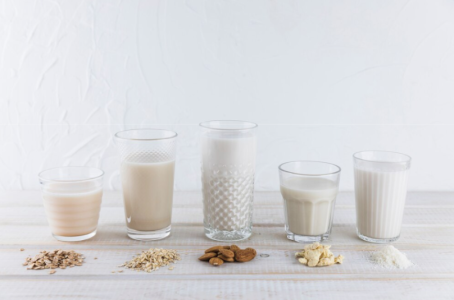Expert reveals your favourite milk may be laced with pesticides—find out the healthiest alternative here!
By
VanessaC
- Replies 0
The world of dairy and dairy alternatives is ever-expanding.
From the traditional cow's milk that has nourished civilisations for millennia to the modern trendy oatmilk and nut milk drawing a loyal and growing following, today's milk section is a cornucopia of choices.
But are all these milk substitutes created equal? And are they even safe? Some alarming reports suggested that the milk you've been enjoying may be affecting your body—and the planet—differently.
Understanding the numerous options can help health-conscious consumers navigate this 'milky way' and make the best decisions for their body.
Let's dive into this 'creamy' ocean and sift through the different options.
When it comes to nutrient density, traditional cow's milk is hard to surpass.
It provides an impressive amount of protein—approximately eight grams in an eight-ounce glass.
Additionally, it carries around 30 per cent of everyday calcium needs, phosphorus, and vitamin B2.
All these contribute to stronger bones and optimal energy levels.
Cow's milk, available in whole, reduced fat, low-fat, and fat-free (or skim) forms, has been linked in some research to a lower risk of bone density loss in old age. Its high protein content, besides keeping consumers satiated, has been associated with better bone mineral density.
Moreover, cow's milk contains potassium and magnesium, two nutrients known to safeguard people against strokes.
However, high dairy intake has been associated with an increased likelihood of dying from heart disease and cancer, so moderation is crucial.
And for 4 per cent of Aussies grappling with some level of lactose intolerance, cow's milk is certainly not an option.
In the crowded field of plant-based milk, soy milk stands out as the most nutrient-rich choice.
The protein content of soybeans is commendable, packing six grams and at least 20 per cent of your daily calcium and B12 needs.
However, there are valid concerns about the widespread use of genetically modified soybeans, engineered to have better herbicide and pesticide resistance.
Although these modifications have not been demonstrated to affect nutritional value or human health, some apprehensions still persist.
Moreover, the potential perceived risk with soy’s phytoestrogens’ impact on breast cancer appears more nuanced than initially feared, with some recent studies indicating a potential protective effect.
Researchers in China found that consuming high amounts of soy was associated with a 66 per cent lower risk of death from any cause and a 64 per cent lower risk of death from breast cancer.
Higher soy intake after a breast cancer diagnosis was associated with 64 per cent lower risk of death from any cause and 51 per cent lower risk of death from breast cancer.
Furthermore, oat milk’s recent rise in popularity was accompanied by some legitimate health concerns, with the most notable being its propensity to spike blood sugar levels.
'Oat milk comes from oats, oats are a grain, and grains are starch. So, when you’re drinking oat milk, you’re drinking starch juice. You’re drinking juice with a lot of glucose in it—so it leads to a big glucose spike,' Biochemist Jessie Inchauspé said.
While people without diabetes can most likely enjoy their oat milk latte without worrying about a blood sugar spike, diabetics should be extra cautious.
Oat milk also tends to lag behind dairy and soy milk in its protein content, though it does score higher on fibre and lower on fat.
Even more troubling is the news that several popular oat milk brands may contain glyphosate, a key ingredient in heavy-duty weed killers such as RoundUp.
'Oat milk is really good in terms of its environmental footprint—very, very low,' Dr Dora Marinova, Professor of Sustainability at the Curtin University Sustainability Policy Institute said.
'Yet it’s grown as a monoculture, which makes it vulnerable to all kinds of bugs and pests. Therefore, we see increased use of pesticides, including glyphosate, which essentially have potentially toxic implications.'
Meanwhile, almond milk presented a relatively poor nutritional profile.
Remarkably, 97 per cent of almond milk is water, and one eight-ounce serving of almond milk boasts only one gram of protein.
Some brands of almond milk also have higher sugar than cow’s milk and are often loaded up with thickeners and flavouring that may undermine the benefits of drinking it in the first place.
But let's not dismiss almond milk entirely—unsweetened varieties are typically low in carbohydrates, and many brands enrich their versions with added vitamins, minerals, and protein.
Additionally, almond milk is naturally rich in vitamin E, a potent antioxidant linked to reducing the risk of heart disease.
Rice milk and coconut milk offer unique alternatives to those seeking non-dairy options. But as always, there are benefits and drawbacks.
Rice milk, which is gluten-free and cholesterol-free, is an acceptable choice for those struggling with celiac disease—but its high carbohydrate content raises red flags for diabetics.
Coconut milk, derived from matured brown coconuts, is rich in magnesium and iron.
However, it's calorie-dense and contains low protein levels, compelling consumers to balance their intake judiciously.
Coconut is also known to have a high glycemic index which may cause a sudden spike in blood sugar.
In the end, choosing the 'best' milk comes down to personal health considerations, lifestyle, and dietary preferences.
It's about understanding each milk's unique nutritional profile and factoring in any potential hidden surprises, like pesticides.
 So, which milk do you prefer and why? Let us know in the comments below!
So, which milk do you prefer and why? Let us know in the comments below!
From the traditional cow's milk that has nourished civilisations for millennia to the modern trendy oatmilk and nut milk drawing a loyal and growing following, today's milk section is a cornucopia of choices.
But are all these milk substitutes created equal? And are they even safe? Some alarming reports suggested that the milk you've been enjoying may be affecting your body—and the planet—differently.
Understanding the numerous options can help health-conscious consumers navigate this 'milky way' and make the best decisions for their body.
Let's dive into this 'creamy' ocean and sift through the different options.
When it comes to nutrient density, traditional cow's milk is hard to surpass.
It provides an impressive amount of protein—approximately eight grams in an eight-ounce glass.
Additionally, it carries around 30 per cent of everyday calcium needs, phosphorus, and vitamin B2.
All these contribute to stronger bones and optimal energy levels.
Cow's milk, available in whole, reduced fat, low-fat, and fat-free (or skim) forms, has been linked in some research to a lower risk of bone density loss in old age. Its high protein content, besides keeping consumers satiated, has been associated with better bone mineral density.
Moreover, cow's milk contains potassium and magnesium, two nutrients known to safeguard people against strokes.
However, high dairy intake has been associated with an increased likelihood of dying from heart disease and cancer, so moderation is crucial.
And for 4 per cent of Aussies grappling with some level of lactose intolerance, cow's milk is certainly not an option.
In the crowded field of plant-based milk, soy milk stands out as the most nutrient-rich choice.
The protein content of soybeans is commendable, packing six grams and at least 20 per cent of your daily calcium and B12 needs.
However, there are valid concerns about the widespread use of genetically modified soybeans, engineered to have better herbicide and pesticide resistance.
Although these modifications have not been demonstrated to affect nutritional value or human health, some apprehensions still persist.
Moreover, the potential perceived risk with soy’s phytoestrogens’ impact on breast cancer appears more nuanced than initially feared, with some recent studies indicating a potential protective effect.
Researchers in China found that consuming high amounts of soy was associated with a 66 per cent lower risk of death from any cause and a 64 per cent lower risk of death from breast cancer.
Higher soy intake after a breast cancer diagnosis was associated with 64 per cent lower risk of death from any cause and 51 per cent lower risk of death from breast cancer.
Furthermore, oat milk’s recent rise in popularity was accompanied by some legitimate health concerns, with the most notable being its propensity to spike blood sugar levels.
'Oat milk comes from oats, oats are a grain, and grains are starch. So, when you’re drinking oat milk, you’re drinking starch juice. You’re drinking juice with a lot of glucose in it—so it leads to a big glucose spike,' Biochemist Jessie Inchauspé said.
While people without diabetes can most likely enjoy their oat milk latte without worrying about a blood sugar spike, diabetics should be extra cautious.
Oat milk also tends to lag behind dairy and soy milk in its protein content, though it does score higher on fibre and lower on fat.
Even more troubling is the news that several popular oat milk brands may contain glyphosate, a key ingredient in heavy-duty weed killers such as RoundUp.
'Oat milk is really good in terms of its environmental footprint—very, very low,' Dr Dora Marinova, Professor of Sustainability at the Curtin University Sustainability Policy Institute said.
'Yet it’s grown as a monoculture, which makes it vulnerable to all kinds of bugs and pests. Therefore, we see increased use of pesticides, including glyphosate, which essentially have potentially toxic implications.'
Meanwhile, almond milk presented a relatively poor nutritional profile.
Remarkably, 97 per cent of almond milk is water, and one eight-ounce serving of almond milk boasts only one gram of protein.
Some brands of almond milk also have higher sugar than cow’s milk and are often loaded up with thickeners and flavouring that may undermine the benefits of drinking it in the first place.
But let's not dismiss almond milk entirely—unsweetened varieties are typically low in carbohydrates, and many brands enrich their versions with added vitamins, minerals, and protein.
Additionally, almond milk is naturally rich in vitamin E, a potent antioxidant linked to reducing the risk of heart disease.
Rice milk and coconut milk offer unique alternatives to those seeking non-dairy options. But as always, there are benefits and drawbacks.
Rice milk, which is gluten-free and cholesterol-free, is an acceptable choice for those struggling with celiac disease—but its high carbohydrate content raises red flags for diabetics.
Coconut milk, derived from matured brown coconuts, is rich in magnesium and iron.
However, it's calorie-dense and contains low protein levels, compelling consumers to balance their intake judiciously.
Coconut is also known to have a high glycemic index which may cause a sudden spike in blood sugar.
In the end, choosing the 'best' milk comes down to personal health considerations, lifestyle, and dietary preferences.
It's about understanding each milk's unique nutritional profile and factoring in any potential hidden surprises, like pesticides.
Key Takeaways
- Dairy milk is the most nutrient-dense choice and is linked to strong bones and energy provision, but may not suit those with lactose intolerance or certain health conditions.
- Soy milk is a good plant-based alternative with a complete protein profile; however, some concerns remain about its phytoestrogens and genetically modified origins.
- Oat milk is environmentally friendly with a low carbon footprint, but its high starch content can lead to blood sugar spikes.
- Almond milk is also a popular choice despite a weaker nutritional profile.









